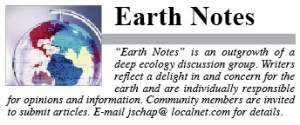Earth Notes: When will we ever learn
 By Peter Bollen
By Peter Bollen
Three years have passed since the earthquake and tsunami that caused the nuclear disaster at the Fukushima Daiiki nuclear power plant in Japan. The tsunami’s immediate death toll was more than 15,000, with close to 3,000 missing.
• The casualties are still mounting both in Japan and much farther away. The impact of this nuclear meltdown on health and the environment is severe, compounded daily as radioactive pollution continues to pour from the site, owned by Tokyo Electric Power Company, (TEPCO).
It’s been reported that 80,000 tons of radioactive water was released during the meltdown.
In the wake of this crisis, an American aircraft carrier, the USS Ronald Reagan, was sent for humanitarian aid. Eight months later, sickness symptoms were reported by members of the crew. By June of 2013, 51 sailors and Marines reported the contracting of illnesses including thyroid, brain and testicular cancers, unusual uterine problems — problems you do not see in a population of 20 to 23-year-olds, even 35-year-olds.
There is presently a class-action lawsuit for approximately a hundred sailors. The responsibility for the young sailors’ injuries is TEPCO for failing to tell the public, including the Navy, they were in an active meltdown. They didn’t have batteries or backup power or any kind of auxiliary water supply to cool these reactors down. TEPCO is the fourth largest power company in the world, but was inept to control this disaster on all fronts. The fallout from this disaster continues.
Accidents and leakages of nuclear disasters isn’t news to observers over the years and there have been dangerous incidents, as well in the implementation of nuclear weaponry and its storage problems. I will refer the reader to a recently published book by investigative reporter, Eric Schlosser. The book, Command and Control, examines the history of nuclear risks, including the many accidents and near-disasters. The reading is not for the faint-hearted and may disturb and enrage those who feel the population is in constant safe hands.
As technical progress makes nuclear weapons cheaper and easier to build, and creates new and ever more dangerous weapons of mass destruction, the intractable problems of safe storage and a nuclear war-fighting doctrine are likely to remain with us for the long term — so states Walter Russell Mead, a foreign affairs expert, in reviewing Schlosser’s book.
Good environmental policy is an ongoing problem and challenge all across the globe. Nuclear waste and its panoply of related problems is one increasing blight in this mix. I’ll end this column with the words of former UK ambassador to the United Nations, Sir Crispin Tickell. There are only three ways you get good environment policy changes: (1.) Political leadership, via individuals or movements; (2.) Pressure from below, from the public at large, when the women and men in the streets get fed up with the poison in the air, water landfill, exhaust fumes, etc.; (3.) Catastrophe.
When things get so bad nothing else will move the debate, Tickell concludes, “You can have a beneficial catastrophe.â€
Yes, reactor catastrophes have slowed but not stopped the constructions of these power plants. It reminds me of the song, Where Have all the Flowers Gone — “when will we ever learn?â€
• Source used, Amy Goodman/Democracy Now
Peter Bollen, a Bridgton resident, is the author of Nuclear Voices.


